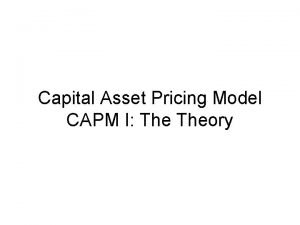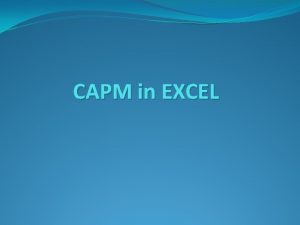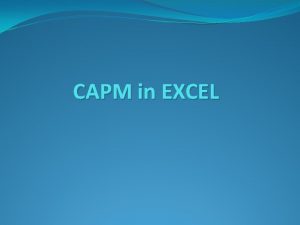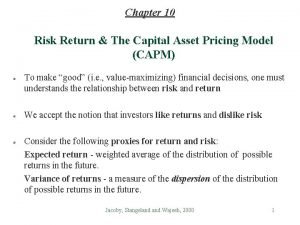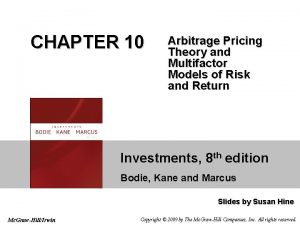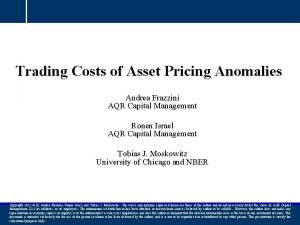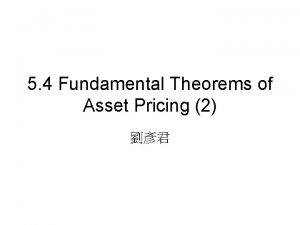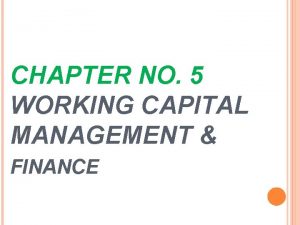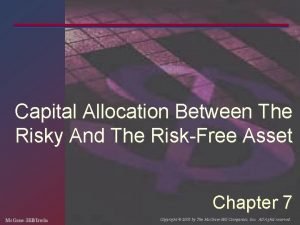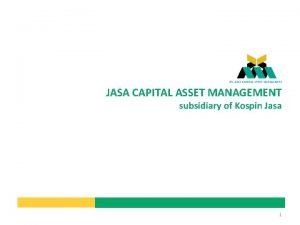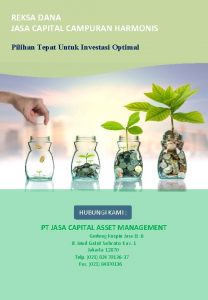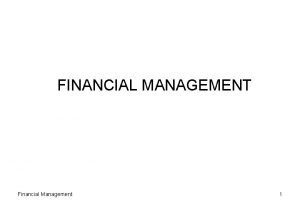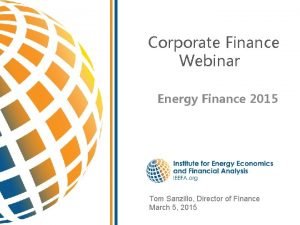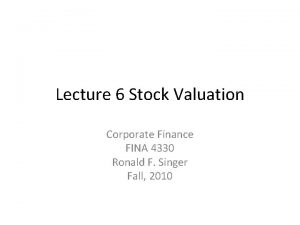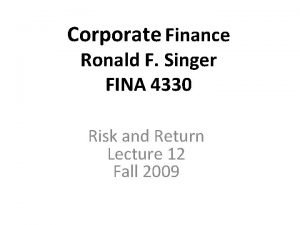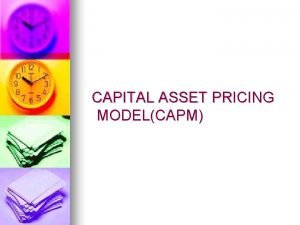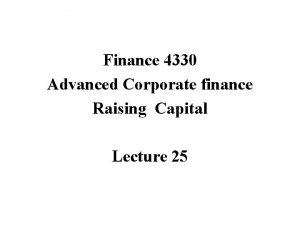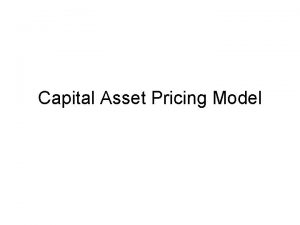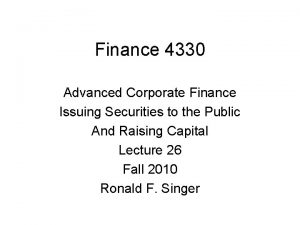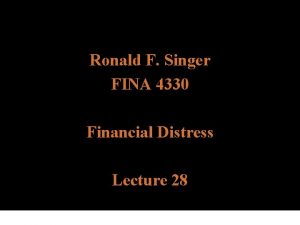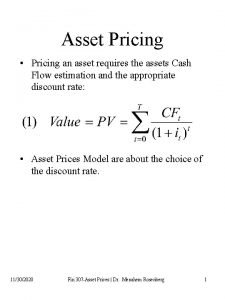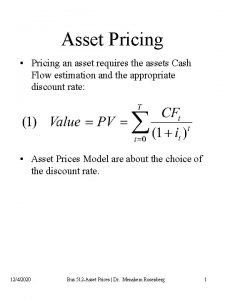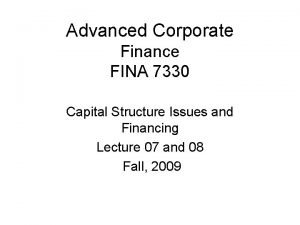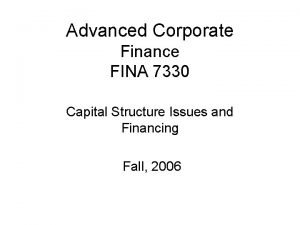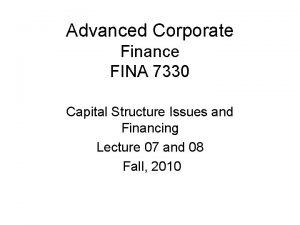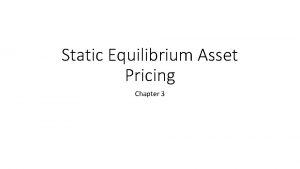Corporate Finance FINA 4330 The Capital Asset Pricing

















- Slides: 17

Corporate Finance FINA 4330 The Capital Asset Pricing Model (CAPM) Lecture 12 Fall, 2010

Simplifying Assumptions • Individuals can trade securities without regard to fees, taxes, and other frictions. • Individuals get any relevant information about the firms they are interested in costlessly. • Individual investors can borrow or save at the same riskless rate equal the “riskfree rate”

Summary and Conclusions • The contribution of a security to the risk of a well-diversified portfolio is proportional to the covariance of the security's return with the market’s return. This contribution is called the beta. • The CAPM states that the expected return on a security is positively related to the security’s beta:

Security Returns Estimating b with regression ne i L c i t s i r e t ac r a h C Slope = bi Return on market % Ri = a i + b i Rm + e i

Practical Issues in CAPM • Forecasting Beta – The problem is that you assume your estimate of Beta is the true value of Beta – “regression toward one” – Allow for extremes – What Time Horizon • 2 years of weekly, or 5 years of monthly

The Security Market Line • Risk free interest rate? • The Market Risk Premium 5. 7%

Firm valuation • We will want to value the firm using the Discounted Cash Flow (DCF) method. • Three issues: – What do you want to discount? – How do you project this over time? – How do you discount it?

Basic Valuation • What do you want to Discount? • How do you project these? • How do you discount these?

Basic Valuation • What do you want to Discount? – Free Cash Flow • How do you project these? • How do you discount these?

Basic Valuation • What do you want to Discount? – Free Cash Flow • How do you project these? – From Historical Data • How do you discount these?

Basic Valuation • What do you want to Discount? – Free Cash Flow • How do you project these? – From Historical Data • How do you discount these? – The Cost of Capital or (Weighted Average)

Free Cash Flow • Start with EBIT • Subtract Taxes • Leaves EBIT(1 -t) = Unlevered (Operating) Net Income • Plus Depreciation • Less Capital Expenditures • Less Increases in Working Capital • Bottom Line: = Free Cash Flow

Example: Current Sales = Cost of Goods Sold Gross Profit Less Operating Expenses Less Depreciation EBIT Less Income Tax Rate (@ 35%) Operating (Unlevered) NI Plus Depreciation Less Capital Expenditures Less Increases in Working Capital Free Cash Flow $60 25 35 9 6 20 7 13 6 2 1 16

Discount Rate • Conceptually: V = Present Value of the firm’s Cash flows, discounted by a number called the “cost of capital” Basically it is the IRR of the Firm. Conceptually, you want to discount by a rate that reflects the risk of the firm’s operating Cash Flow.

How do you estimate this • Weighted Average Cost of Capital Once you have the stream of Cash Flows generated by the firm, the next problem is to determine how to discount it. The discount rate that makes the Value of the firm equal the firm’s cash flow is what we call the Cost of Capital. As a practical matter this can be approximated by the Weighted Average Cost of Capital (WACC)

WACC • The WACC is defined as: r. WACC = r. E X (E/(E+D+P)) + r. D(1 -t) X (D/(E+D+P)) + r. P X (P/(E+D+P)) The weighted average of the (after tax) cost of the component securities issued by the firm, weighted by the proportion of those securities issued by the firm. r. E is the required return to the equity of the firm r. D is the required return to the debt of the firm D is the (market value) of the debt issued by the firm E is the market value of the equity. t is the statutory tax rate. r. P is the required return to the preferred stock of the firm P is the (market value) of the preferred stock issued by the firm

WACC Estimation • Some of these variables are not easily estimated so we make some assumptions: To estimate D use the Book value of the debt. To estimate r. D use the ratio of Total Interest payments to the total book value of the debt To estimate r. E use the Capital Asset Pricing Model
 Capm model
Capm model Capm xls
Capm xls Capital asset pricing model excel
Capital asset pricing model excel Risk return and capital asset pricing model
Risk return and capital asset pricing model Corporate finance and corporate governance
Corporate finance and corporate governance Multifactor apt formula
Multifactor apt formula Abb ellipse erp
Abb ellipse erp Trading costs of asset pricing anomalies
Trading costs of asset pricing anomalies Fundamental theorem of asset pricing proof
Fundamental theorem of asset pricing proof Concept of working capital
Concept of working capital Human capital intangible asset
Human capital intangible asset Capital allocation line formula
Capital allocation line formula Jasa capital asset management
Jasa capital asset management Jasa capital asset management
Jasa capital asset management Fundamentals of corporate finance chapter 6 solutions
Fundamentals of corporate finance chapter 6 solutions Modern finance theory
Modern finance theory Tom sanzillo
Tom sanzillo Investment banking activities
Investment banking activities
